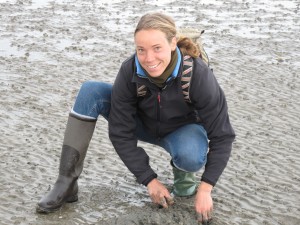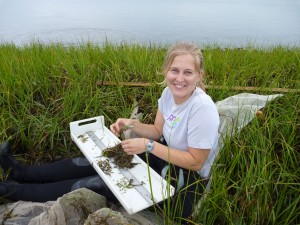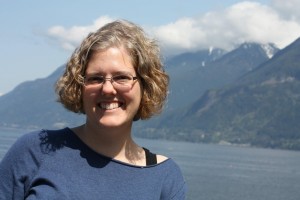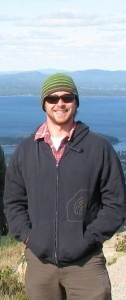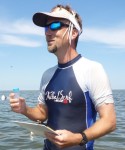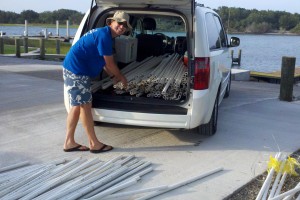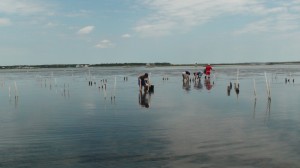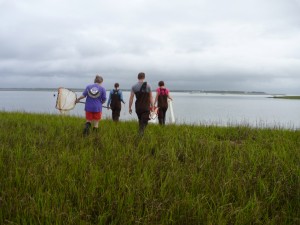Meet the ZEN exchange student fellows!
This summer we have four outstanding graduate students traveling to different ZEN partner sites. These ZEN “exchange student fellows” will be assisting with all aspects of the research at their host sites, from fieldwork to labwork, and in the process learning new research skills and about the local culture. See below for a quick synopsis about each of our four student fellows and stay tuned as they will be writing periodic posts about their experiences throughout the summer.
Serena Donadi is a PhD student at the University of Groningen in the Netherlands advised by Drs. Klemens Eriksson and Jeanine Olsen. Serena assisted with the ZEN experiment at the Northern Norway (NN) site last summer. She is working at the ZEN site in Virginia this summer. Her dissertation research examines the role of mudflat ecosystem engineers (cockels, lugworms, mussels) on sediment stability and the structure of the benthic community in the Wadden Sea.
Rachel Gittman is a PhD student at UNC-Chapel Hill working at the Institute of Marine Sciences in Morehead City, North Carolina, USA, advised by Drs. John Bruno and Pete Peterson. She was the local contact and helped with the ZEN experiments in North Carolina both last and this year. She will be working with Dr. Masakazu Hori at the southern Japan site (JS) and assisting with projects at the northern Japan site (JN) starting at the end of July. For her dissertation, Rachel is studying the effects of shoreline development on functioning in salt marsh and seagrass habitats in coastal North Carolina in addition to exploring food web interactions in these systems.
Nicole Kollars is a master’s student at the College of Charleston in Charleston, South Carolina, USA, advised by Dr. Erik Sotka. She assisted with the ZEN experiment in North Carolina (NC) this summer and will be working with Dr. Massa Nakaoka at the northern Japan (JN) site starting at the end of July. Nicole’s master’s research focuses on the ecological roles of the invasive red seaweed Gracilaria vermiculophylla in the mudflats of the southeastern USA.
Maxwell Overstrom-Coleman is a PhD student at Dartmouth University in Hanover, New Hampshire, USA, advised by Dr. Brad Taylor. He recently started working at the ZEN site in Massachusetts with Dr. James Douglass. Max’s dissertation work focuses on the role of eelgrass as foundation species and their effects on abiotic habitat parameters in estuaries in the northeastern USA.
Road trip to North Carolina
by Paul Richardson (VIMS technician)
photos by Pamela Reynolds (ZEN coordinator)
The road trip begins!
On Friday, June 1, 2012 undergraduate student Katelyn Jenkins and I loaded up a fancy Ford F-150 rental truck with filters, jars, vacuum pumps, and neoprene and set out for The University of North Carolina’s at Chapel Hill’s Institute of Marine Sciences (UNC-IMS) in Morehead City, North Carolina to help Erik Sotka’s (College of Charleston) group break down this summer’s main ZEN experiment. It was a marathon of work, but the good company, nice scenery, rocking tunes, and Oreo cookie snacks made the time fly. We amassed a large group for the effort. Erik’s graduate students, Nicole Kollars and Courtney Gerstenmeier, and his REU intern, Aaron joined Katelyn and me along with UNC-IMS local, Alyssa Popowich to comprise a formidable experimental breakdown team.
Katelyn and I arrived a bit earlier on Friday than the South Carolina contingent, so we helped Alyssa prepare tin envelopes that are used for drying samples in the lab. This prep work was a key task and streamlined the next two days. After helping Alyssa, we grabbed a quick dinner in town and then met up with Erik’s crew. As with any major experimental endeavor, a trip to the store was necessary for last minute supplies which this time included hundreds of Ziploc bags for collecting and storing field samples.
Rocking out in the field and the lab
This was our first major ZEN experiment event in North Carolina without the presence of Pamela Reynolds, the ZEN coordinator, which made us all a bit nervous, but her and Erik’s extensive planning paid off and this was an extremely efficient and productive experimental breakdown. I really enjoyed working with Erik and his crew. Everyone was so positive and they all had an unyielding work ethic. I also learned something interesting about Erik when I asked about the band that he played in back when he was in graduate school. Pamela tipped me off to this fact but she was vague on the details. When I asked Erik, he said it was his only “brush with fame” when he played with the band Cake before they were big. Wow, what a huge ‘brush’! I love Cake. As you may know, Cake is a talented rock band from Sacramento, California with a keystone trumpeter, Vince DiFiori. As Erik said, “Cake would not be Cake without the trumpet,” and I agree! But, during Cake’s embryonic stage they experimented with other wind instruments which included Erik on the saxophone. In another universe, Erik is a music rock star. In this universe, he has to settle with being a marine ecology rock star. Tough break.
Luckily Aaron brought his iPod loaded with thousands of great songs, which kept things lively in the lab as we processed samples. I know it sounds like I’m getting off track here, but good music is essential for tedious long stretches of labwork!
Never a boring moment
One thing that we didn’t do was go sightseeing. Before we left Pamela told me that I should check out some of the various parks andbeaches, (including Fort Macon) if I had the time. While we didn’t have any extra time for sightseeing (I’ll save that for a family vacation) I did see plenty of pretty sights during the course of our field work. Carrot Island on the right and the town of Beaufort on our left made for nice scenery as we motored out to the field site in a local Carolina skiff. A short boat ride towards the inlet brought us to the field site in the Rachel Carson Reserve, which is adjacent to a gorgeous system of Spartina marsh islands called Middle Marsh.
Comparing Virginia and North Carolina
At first glance, the marine environment of Bogue Sound appears similar to the Chesapeake Bay but a critical eye will notice some striking differences. The most conspicuous difference that I noticed was the abundance of intertidal oyster reefs. We had to traverse one to get to our seagrass bed. We used to have numerous oyster reefs in the Chesapeake, but overfishing and disease have had their toll and they have yet to recover. Another interesting comparison was the abundance of sea urchins and brittle stars at Middle Marsh. These animals are rarely, if at all, found in the York River and western side of the Chesapeake Bay, but were all over the place at Middle Marsh. I even saw an urchin hanging out in the middle of one of our experimental plots!
Tiny drifters make fieldwork challenging
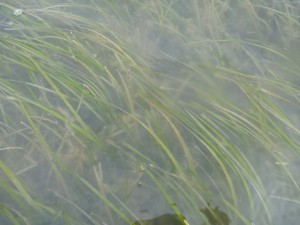
Eelgrass at the ZEN field site in Middle Marsh, North Carolina is home to many marine invertebrates, some benign and others best left undisturbed
Another less exciting difference between the VA and NC ZEN sites was the abundance of hydroids (small jellies). As soon as I waded into the knee deep water and began admiring the lush bed of the eelgrass Zostera marina, a stinging sensation spread along my legs. By the end of the day we were all envious of Nicole, who was smart enough to wear knee high neoprene boots. Although it wasn’t as sharp as a bee sting or even your standard sea nettle, the thoroughness of stung surface area did give the mild sensation that the flesh was melting off of my legs. This was especially true when I showered with fresh water that first night and any remaining unengaged nematocysts (the specialized cells jellies sting you with) exploded into my skin. I’m just glad the water was only knee deep! Alyssa and Pamela warned me about this, but it was too hot to wear a wetsuit and I didn’t have an appropriate dive skin. But, I wasn’t the only one, so there was plenty of camaraderie. The stinging took a few days to go away – a not so pleasant reminder of an otherwise enjoyable experimental breakdown!
Wrapping up
Sunday was another marathon, but this time in the lab. We processed seagrass shoots and scraped off the epibionts (animals and plants living on them), and sorted and preserved the associated mesograzers along with other field samples. We split into two teams to divide and conquer! Except for a short lunch break, we went full tilt until, suddenly, it was 7pm. With the fieldwork completed, lab samples processed, and the local lab somewhat straightened up, we packed up our gear and hit the road. What we planned to take us four days we completed in two. We made it back to Virginia a little before midnight and I slept like a rock. The sun, salt and intense fun of fieldwork will always be my preferred sleeping pill!

